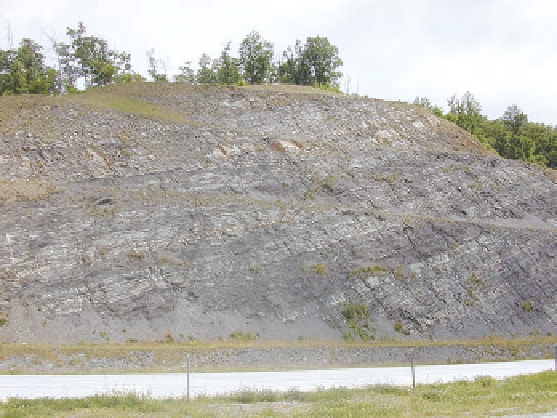Geoscience Reference
In-Depth Information
VISUAL CONCEPT CHECK
13.1
Which one of the following statements is
accurate with respect to the geologic struc-
ture in this roadcut?
a)
The rocks are horizontal.
b)
This is a nice example of a rift system.
c)
The structure shows the limb of an anticline.
d)
The structure shows the base of a syncline.
Seismic Processes
You have no doubt heard about a major earthquake that happened
someplace in your lifetime, perhaps one that devastated a city and
unfortunately killed hundreds or even thousands of people. Ex-
amples abound of recent earthquakes that have made the news in
such a fashion. For example, an earthquake occurred in Java, In-
donesia, in May 2006 and killed over 5000 people. In May 2008
a massive earthquake occurred in central China and killed over
65,000 people. Yet another horrific earthquake struck Haiti in
January 2010, killing over 300,000 people and leaving 1,000,000
homeless. It is quite possible another one will have occurred by
the time you read this text. Clearly, earthquakes are important
natural events that humans should understand.
An
earthquake
occurs when the sudden release of accumu-
lated tectonic stress results in an instantaneous movement of the
Earth's crust. Although this type of movement is usually asso-
ciated with plate boundaries, it can also occur due to the rapid
movement of magma within a volcano. Such movements pro-
duce shock waves that radiate through the lithosphere, causing
the ground to shake in sometimes dramatic ways. The strongest
earthquakes are usually most associated with plate boundaries
because stress builds at these locations as plates grind against
each other. This stress creates a fracture between adjoining plates
called a
fault
, along which the adjacent rock bodies are displaced
relative to each other. At some locations, faults extend deeply into
the Earth's crust, whereas at other places they are very shallow.
Faults and earthquakes can also occur in the middle of plates, but
this association is less common. Although most large earthquakes
occur along major plate boundaries, smaller earthquakes can take
place whenever a small fault occurs within a rock body.
KEY CONCEPTS TO REMEMBER ABOUT
PLATE TECTONICS
1.
The Earth's crust is not a single sheet, but rather a jig-
saw puzzle of interconnected plates.
2.
A variety of evidence (location of fossil remains and
actual measurement of motion) strongly supports the
theory of continental drift, indicating that plates have
shifted through geologic time.
3.
Plate margins can be passive, transform, converging, or
diverging.
4.
At diverging plate margins, magma plumes from the as-
thenosphere cause rifting, either on continents or on the
seafloor.
5.
At converging plate margins, plates collide or subduct
in a variety of settings, causing geomorphic features
such as alpine chains and volcanoes.
Earthquakes
The previous discussion described the various ways in which
plate margins move relative to one another and how mountains
can form in these areas. Now it is time to discuss more specific
processes associated with plate boundaries—volcanism and
earthquakes. The logical place to begin this discussion is with
the concept of earthquakes because they occur both as indepen-
dent events and frequently in association with volcanoes.
Earthquake
Shaking of the Earth's surface due to the instan-
taneous release of accumulated stress along a fault plane or
from underground movements within a volcano.
Fault
A crack in the Earth's crust that results in the dis-
placement of one lithospheric plate or rock body relative
to another.





